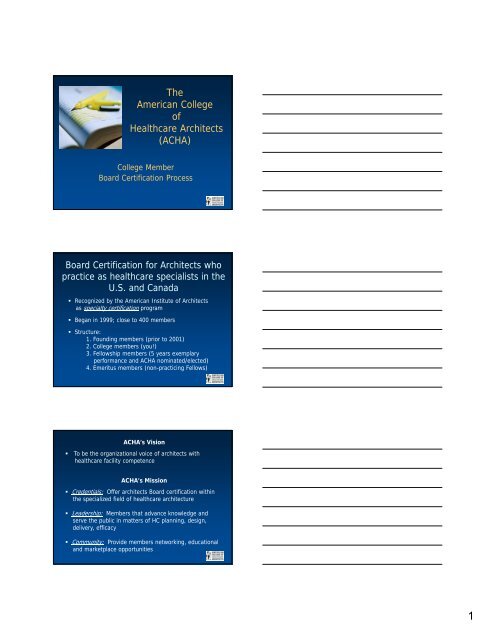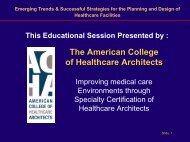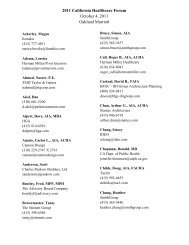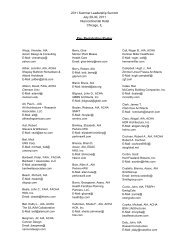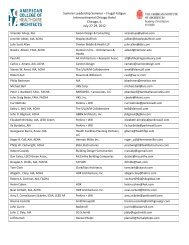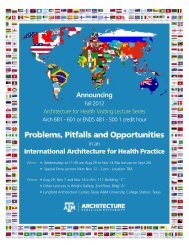The American College of Healthcare Architects (ACHA)
The American College of Healthcare Architects (ACHA)
The American College of Healthcare Architects (ACHA)
You also want an ePaper? Increase the reach of your titles
YUMPU automatically turns print PDFs into web optimized ePapers that Google loves.
<strong>The</strong><strong>American</strong> <strong>College</strong><strong>of</strong><strong>Healthcare</strong> <strong>Architects</strong>(<strong>ACHA</strong>)<strong>College</strong> MemberBoard Certification ProcessBoard Certification for <strong>Architects</strong> whopractice as healthcare specialists in theU.S. and Canada• Recognized by the <strong>American</strong> Institute <strong>of</strong> <strong>Architects</strong>as specialty certification program• Began in 1999; close to 400 members• Structure:1. Founding members (prior to 2001)2. <strong>College</strong> members (you!)3. Fellowship members (5 years exemplaryperformance and <strong>ACHA</strong> nominated/elected)4. Emeritus members (non-practicing Fellows)<strong>ACHA</strong>’s Vision• To be the organizational voice <strong>of</strong> architects withhealthcare facility competence<strong>ACHA</strong>’s Mission• Credentials: Offer architects Board certification withinthe specialized field <strong>of</strong> healthcare architecture• Leadership: Members that advance knowledge andserve the public in matters <strong>of</strong> HC planning, design,delivery, efficacy• Community: Provide members networking, educationaland marketplace opportunities1
<strong>ACHA</strong> Guides<strong>ACHA</strong> Executive Office(913) 895-4604acha-info@goamp.comhttp://www.healtharchitects.orgFive Steps to <strong>ACHA</strong> certification:1. Meet the Experience requirements• Practice as a Licensed architect for at least 5 years; majority <strong>of</strong> theapplicant’s full-time practice is within the specialty <strong>of</strong> healthcare facilitiesfor at least 3 <strong>of</strong> last 5 years• Current license in at least 1 State, U.S. possessions or Canada_______________________________2. Complete application3. Secure (6) Letter <strong>of</strong> Recommendation (with application)4. Submit a Portfolio (with application)_______________________________5. Pass the ExamStep 2. Application• <strong>The</strong>re are (6) sections:I. General informationII. Qualifications (license)III. ExperienceIV. Previous Practice/Non-traditional practice narrative(optional)V. Reference Letters• 3 letters <strong>of</strong> recommendation from architects not infirm where employed• 3 letters <strong>of</strong> reference from healthcare clients (canbe different individuals from the same provider)VI. Portfolio2
Sample Portfolio sheetSample Portfolio sheetCompleted Applications• Submit:A. (1) Copy <strong>of</strong> original application & portfoliobound in 8 ½” X 11” loose-leaf formatB. (1) CD containing all <strong>of</strong> the application andportfolio pages saved in Adobe .pdf• Fees: $150 Application; $250 Exam5
Application DeadlinesApplication deadline is (60) days prior to Exam dates• March Examination CycleApplication Deadline: December 31Exam dates: March 1 thru 31st• June Examination Cycle:Application Deadline: March 31Exam dates: June 1 thru June 30 th• September Examination CycleApplication Deadline: June 30Exam dates: September 1 thru 30th4. Exam Preparation• Upon acceptance <strong>of</strong> application, the <strong>ACHA</strong> Executive Officesends via e-mail examination scheduling instructions• Eligible Candidates have (1) year to take the examination• Candidate Handbook: All about the Exam (reading list)• <strong>ACHA</strong> Planning & ProgrammingWorkshops (check website)• Practice Exam (50) questions; $50http://www.healtharchitects.org• Find a mentor; contact the<strong>ACHA</strong> <strong>of</strong>ficeExam Content Areas1. Planning 202. Programming 193. Design 274. Documentation 175. Construction Admin 116. Post Construction 6Total: 100 questions6
Exam Resource List• Guidelines for Design and Construction <strong>of</strong> Hospital and HealthCare Facilities Facility Guidelines Institute, <strong>American</strong> Institute <strong>of</strong><strong>Architects</strong>, Academy <strong>of</strong> Architecture for Health., current edition.• National Fire Protection Association. Specific codes and standardsinclude: NFPA 101: Life Safety Code current edition.• <strong>American</strong>s with Disabilities Act (ADA) Accessibility Guidelinesfor Buildings and Facilities. 36 CFR 1191, Washington, DC:Government Printing Office, current edition• Planning, Design, and Construction <strong>of</strong> Health Care Facilities,Joint Commission Resources, Oakbrook Terrace, IL, current editionAs listed on the <strong>ACHA</strong> Website: http://www.healtharchitects.orgPlanning and ProgrammingPlanning & Programming: 39% <strong>of</strong> the Exam!Planning• Strategic Planning• Feasibility• Site and Facilities Master PlanningProgramming• Program (multipliers) NSF to DGSF to BGSF• Adjacency <strong>of</strong> Departments• Work Flow & Process• Industry standards and directionDesign and DocumentationDesign• Facilities Code Research• Space Requirements and Adjacencies• Room Data Sheets• Equipment PlanningDocumentation• Contracts• Construction Documents• Specifications7
Construction Admin andPost ConstructionConstruction Administration• Government Review• Issue Changes• Review Owner Provided EquipmentPost Construction Services• Commissioning• Post Occupancy Evaluation• Research and Development4. Exam PreparationHelpful hints . . .• Read questions carefully to decipher what is being askedprior to reading answers• All questions are based on the Detailed Content Outline inthe Candidate Handbook• <strong>ACHA</strong> Website (go to: home/application/study materials)“Helpful hints for the <strong>ACHA</strong> Exam”Exam Format• 110 questions (10 not scored)(<strong>The</strong> 10 not scored are being tested prior to their usein future exams; data is collected on number <strong>of</strong>correct answers over 1 year <strong>of</strong> exams)• All Options (A, B, C, D) are plausible• (2) hour time limit• Score automatically generated after hitting ‘send’ !8
Question Types• Recall/recognition <strong>of</strong> specific factual information 20• Application: comprehension, interpretation ormanipulation <strong>of</strong> concepts or data; basic calculationsor finding relationships between concepts 45• Analysis: integration <strong>of</strong> a variety <strong>of</strong> concepts to solvea problem; an understanding <strong>of</strong> the variables willprovide the correct answer 35Total: 100Exam Question 1When considering the design forinformation systems in any inpatient oroutpatient healthcare project, theacronym EMR refers to:A. Equipment Management RosterB. Electronic Medical RecordC. Emergency Medical ResponseD. Electrical Maintenance ReportExam Question 2Which <strong>of</strong> the following design criteria isLEAST important in planning a pediatriccritical care unit?A. Visibility <strong>of</strong> the PatientB. Ability to Accommodate Patient FamiliesC. Access to Patient ToiletsD. Ability to Accommodate CrisisInterventions9
Exam Question 6In the programming analysis <strong>of</strong> spaces ina hospital, which <strong>of</strong> the followingconditions present the most significantoperational challenges?1. Surgery separated from SICU2. C-section separated from OB Unit3. Pathology separated from Surgery4. Emergency separated from ImagingA. 1, 2, and 3 onlyB. 1, 2, and 4 onlyC. 1, 3, and 4 onlyD. 2, 3, and 4 onlyExam Question 7A common departmental adjacencyrelationship would be to locate a ClinicalDecision Unit (CDU) adjacent to which <strong>of</strong>the following departments:A. SurgeryB. Medical recordsC. EmergencyD. Nursing unitsExam Question 8Which is one <strong>of</strong> the most dynamiccomponents for staffing <strong>of</strong> a 125 bedsuburban community hospital due tocyclical demand?A. intensive careB. emergencyC. ambulatory surgeryD. imaging11
Exam Question 9When designed a rural Critical Access Hospital,which <strong>of</strong> the following is the most importantaspect <strong>of</strong> the plan?A. Efficient use <strong>of</strong> pr<strong>of</strong>essional staffB. Lower maintenance costsC. Outpatient accessD. Helipad location on siteExam Question 10Per the Guidelines negative air pressure isfound in which <strong>of</strong> the following rooms?1. Emergency Triage Room2. Emergency Waiting Room3. Operating Rooms4. Patient Toilet RoomA. 1, 2, and 3 onlyB. 1, 2, and 4 onlyC. 1, 3, and 4 onlyD. 2, 3, and 4 onlyExam Question 11Nuclear Imaging scans typically allowobservations <strong>of</strong> which <strong>of</strong> thefollowing?A. Brain activity thru electronic physiologicalmonitoringB. Ambulatory EKG recorded over a 24 hour periodC. EEG & EKG monitoring via both video & audiomonitoringD. Cardiovascular performance through monitoring& SPECT (single proton emission computedtomography)12
Exam Question 12Vibration considerations must be usuallyconsidered in the ceiling mountedequipment for which types <strong>of</strong> surgery?1. Neurological2. Ophthalmic3. Oral4. CardiovascularA. 3 and 4 onlyB. 2 and 4 onlyC. 1 and 2 onlyD. 1 and 3 onlyExam Question 13What is the maximum allowablearea for a smoke compartment ina hospital?A. 21,500B. 22,000C. 22,500D. 23,000Exam Question 14An existing two-story hospital is addingmore patient beds. When preparing ananalysis to determine whether to expandvertically or horizontally, which <strong>of</strong> thefollowing should be done first?A. Evaluate potential disruptions.B. Confirm the existing structural capacity.C. Determine exiting requirements.D. Analyze sharing <strong>of</strong> utility services.13
Exam Question 15At the completion <strong>of</strong> a large project to provideinpatient beds, all the final project documentshave been collected. <strong>The</strong> air balance for bonemarrow transplant patient rooms is neutral with12 air changes per hour. <strong>The</strong> architect shouldinstruct the contractor toA. decrease air changes.B. adjust for positive air balance.C. adjust for negative air balance.D. increase air changes.Continuing Education• Passing the test: (20) HSW AIA CEU’s• <strong>ACHA</strong> Members are required to maintain (18) CEU/year; (12)hours must be healthcare related• <strong>The</strong> AIA CEU form is acceptable for submissionQuestions ?<strong>ACHA</strong> Executive Office(913) 895-4604acha-info@goamp.comhttp://www.healtharchitects.org14
Sample Question Answers1. B2. C3. B4. B5. A6. B7. C8. B9. A10. B11. D12. C13. C14. B15. B15


